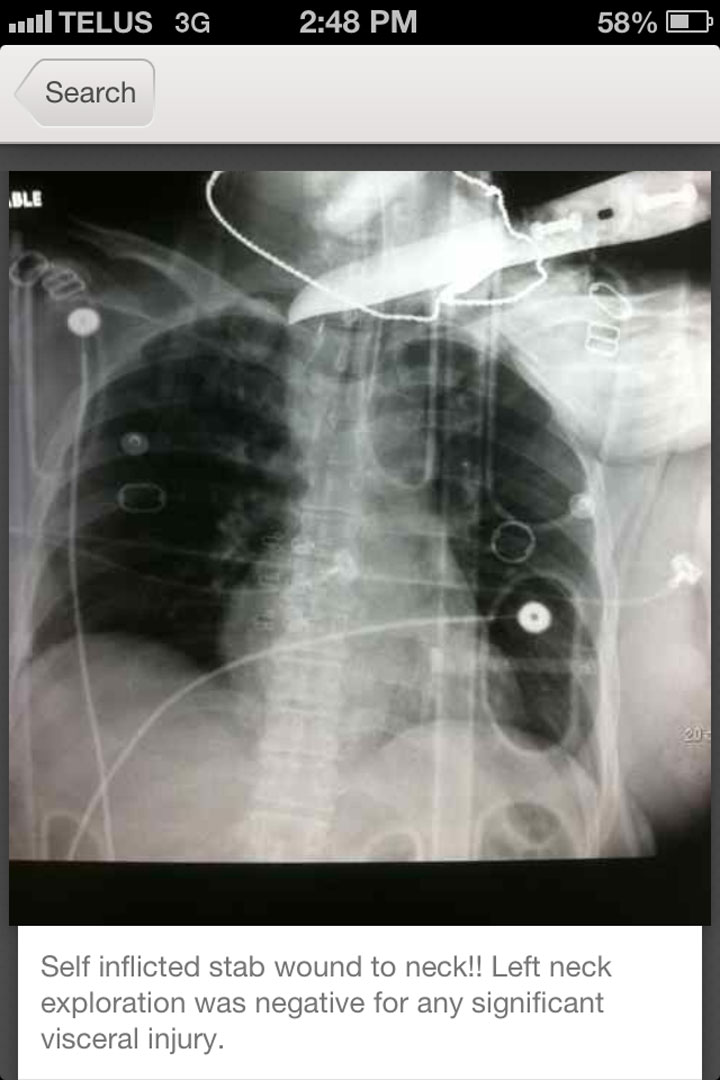TORONTO – If there is one lesson that Toronto-based critical care doctor Josh Landy has learned during his time as a health-care professional, it’s that medicine is anything but textbook.

A rash on the arm of a 60-year-old diabetic woman, he explains, could be very different from an almost identical rash on the arm of a teenage cancer patient.
With that in mind, Landy, along with a team of Toronto-based developers and health-care professionals, designed the ‘Figure 1’ app – a photo-sharing app reminiscent of popular social network Instagram, designed solely for medical practitioners.
“Essentially it’s photo sharing for healthcare,” Landy told Global News.
But you won’t find any ‘Valencia’ or ‘Hefe’ photo filters here – just photos of interesting or unique medical conditions, from bizarre X-rays of objects stuck in the human body, to stomach-churning close-ups of tumors.
Doctors can upload an archived photo with an explanation of diagnosis and condition, or even upload a photo on the spot to help diagnosis.
Once the photo is uploaded the user can add annotations to the photo, using arrows to draw attention to infections or oddities on an X-ray, and include a description of the photo that might include the patient’s medical history for background.
Landy said that the purpose of the app is simple – allow medical professionals a place that provides a crowdsourced visual encyclopedia of conditions.
“By sharing these images I feel like we are helping to educate health-care professionals,” stressed Landy, co-founder of Figure 1.
“I feel like it’s an easy argument to make that educating doctors saves lives.”
But those searching for a new mobile health app need not apply – the app is not for the faint of heart.
Upon first glance, the app may reveal a photo of a tick bite on a patient in Manitoba; further scrolling may reveal a removed appendix, or even an amputated leg.
Landy stresses that the app is designed for medical professionals, not patients looking for a speedy diagnosis.
- Life in the forest: How Stanley Park’s longest resident survived a changing landscape
- Bird flu risk to humans an ‘enormous concern,’ WHO says. Here’s what to know
- Roll Up To Win? Tim Hortons says $55K boat win email was ‘human error’
- Election interference worse than government admits, rights coalition says
“We wanted to make sure that the content on the site is paired with the ability to consume it. So what we don’t want is people taking pictures of their arms and legs and saying, ‘Hey doc, what is this?’ This is not a diagnostic tool – this is an educational tool,” said Landy.
However Landy, who studied medical education and technology this past summer, noted that the team is looking into the possibility of a patient-driven diagnostic tool.
“The use of having patients email images or send images to their health care professional is a great one and we are looking into how that could be done,” said Landy.
“But once you enter into that field it’s very different and you need a very robust infrastructure. We, as most startups, don’t have the capacity at this stage.”
Eventually, Landy hopes the app can evolve into an online community that would serve as a free encyclopedia of medical conditions that both practicing physicians and medical students could use to broaden their knowledge of healthcare.
“The reason why we built this is because a lot of health care professionals keep interesting images of medical conditions on their smartphones already,” said Landy.
“Because this is already a way that people are sharing information, we wanted to make sure that it was done safely and securely, as well as harness the power of these hundreds of thousands of images that people are sharing all the time – but might only be shared between one or two people.”
Technology
The app has many privacy features in place to ensure patient confidentiality.
Not only does the app have software that automatically detects the patients’ face, if visible in the photo, and blocks it, but the app reminds the user to block out any information that might identify a patient.
“You have to use the manual blocking feature to remove any private data – from their health card number (if it appears) to their name, which is fairly common,” explained Landy.
The app also uses a hashtag index model so that users can search and add content by hashtag.
For example, users could upload a photo of a chest X-ray with #chestxray so that anyone looking to compare those images can easily find them.
Moving Forward
The project, launched just two weeks ago in partnership with the Digital Media Zone at Toronto’s Ryerson University, has already attracted thousands of users from the U.S. and Canada despite only being available on the iPhone.
“Being a small group, we had to start with a test market and because over 50 per cent of the health care industry uses iPhones we started with that market,” said Landy.
“There are more than 13,000 health-care apps for iPhone, but it’s a solid field in the iPhone app store and we are among good company.”
Landy said that the group hopes to expand Figure 1 to all platforms eventually, including a web-based platform.




Comments